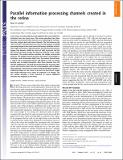| dc.contributor.author | Schiller, Peter H. | |
| dc.date.accessioned | 2011-04-22T18:18:48Z | |
| dc.date.available | 2011-04-22T18:18:48Z | |
| dc.date.issued | 2010-08 | |
| dc.date.submitted | 2010-10 | |
| dc.identifier.issn | 0027-8424 | |
| dc.identifier.issn | 1091-6490 | |
| dc.identifier.uri | http://hdl.handle.net/1721.1/62298 | |
| dc.description.abstract | In the retina, several parallel channels originate that extract different attributes from the visual scene. This review describes how these channels arise and what their functions are. Following the introduction four sections deal with these channels. The first discusses the “ON” and “OFF” channels that have arisen for the purpose of rapidly processing images in the visual scene that become visible by virtue of either light increment or light decrement; the ON channel processes images that become visible by virtue of light increment and the OFF channel processes images that become visible by virtue of light decrement. The second section examines the midget and parasol channels. The midget channel processes fine detail, wavelength information, and stereoscopic depth cues; the parasol channel plays a central role in processing motion and flicker as well as motion parallax cues for depth perception. Both these channels have ON and OFF subdivisions. The third section describes the accessory optic system that receives input from the retinal ganglion cells of Dogiel; these cells play a central role, in concert with the vestibular system, in stabilizing images on the retina to prevent the blurring of images that would otherwise occur when an organism is in motion. The last section provides a brief overview of several additional channels that originate in the retina. | en_US |
| dc.language.iso | en_US | |
| dc.publisher | National Academy of Sciences (U.S.) | en_US |
| dc.relation.isversionof | http://dx.doi.org/10.1073/pnas.1011782107 | en_US |
| dc.rights | Article is made available in accordance with the publisher's policy and may be subject to US copyright law. Please refer to the publisher's site for terms of use. | en_US |
| dc.source | Michelle Kwak for Prof. Schiller | en_US |
| dc.title | Inaugural Article: Parallel information processing channels created in retina | en_US |
| dc.type | Article | en_US |
| dc.identifier.citation | Schiller, Peter H. “Parallel information processing channels created in the retina.” Proceedings of the National Academy of Sciences 107.40 (2010): 17087 -17094. © 2010 by the National Academy of Sciences | en_US |
| dc.contributor.department | Massachusetts Institute of Technology. Department of Brain and Cognitive Sciences | en_US |
| dc.contributor.approver | Schiller, Peter H. | |
| dc.contributor.mitauthor | Schiller, Peter H. | |
| dc.relation.journal | Proceedings of the National Academy of Sciences of the United States of America | en_US |
| dc.eprint.version | Final published version | en_US |
| dc.type.uri | http://purl.org/eprint/type/JournalArticle | en_US |
| eprint.status | http://purl.org/eprint/status/PeerReviewed | en_US |
| dspace.orderedauthors | Schiller, P. H. | en |
| dc.identifier.orcid | https://orcid.org/0000-0001-8702-6585 | |
| mit.license | PUBLISHER_POLICY | en_US |
| mit.metadata.status | Complete | |
